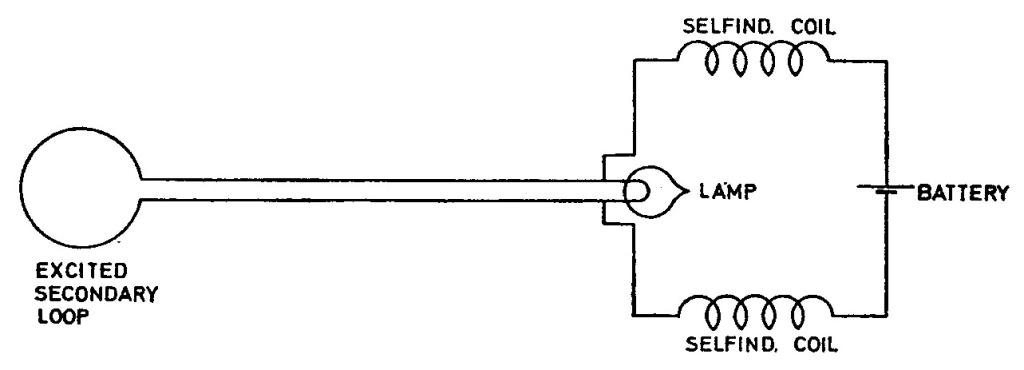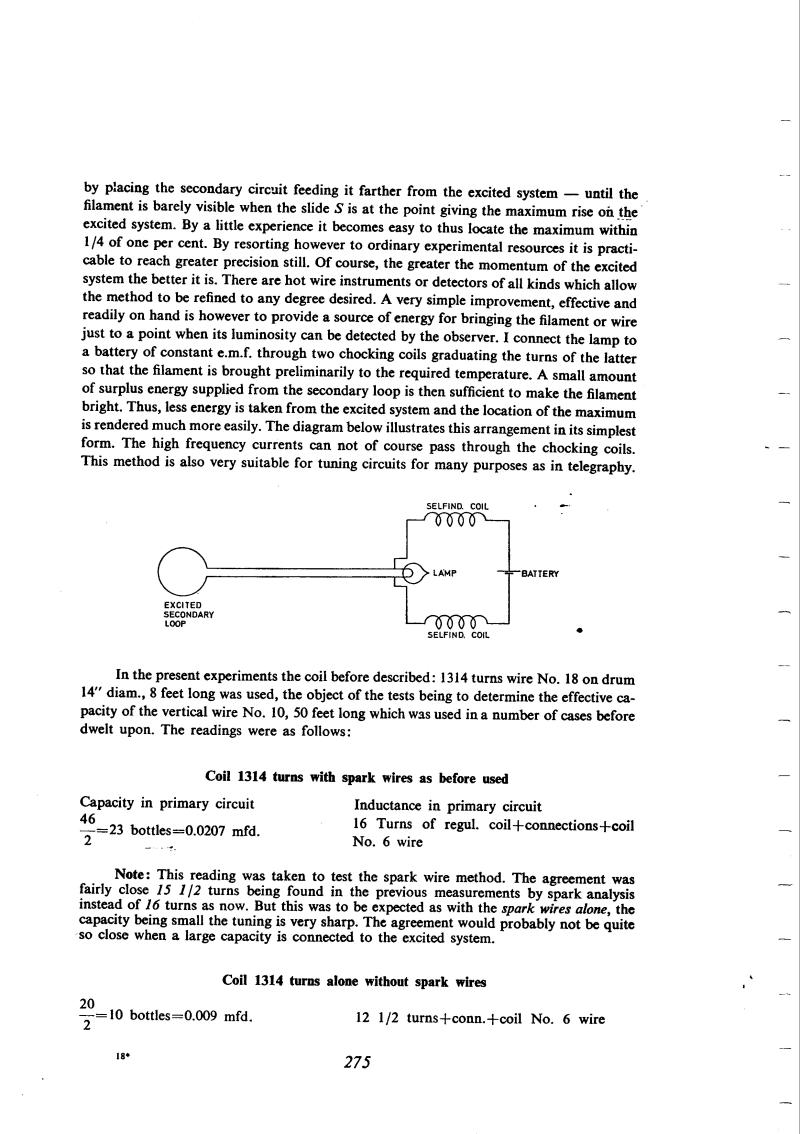
Nikola Tesla Books
by placing the secondary circuit feeding it farther from the excited system - until the filament is barely visible when the slide S is at the point giving the maximum rise on the excited system. By a little experience it becomes easy to thus locate the maximum within 1/4 of one per cent. By resorting however to ordinary experimental resources it is practicable to reach greater precision still. Of course, the greater the momentum of the excited system the better it is. There are hot wire instruments or detectors of all kinds which allow the method to be refined to any degree desired. A very simple improvement, effective and readily on hand is however to provide a source of energy for bringing the filament or wire just to a point when its luminosity can be detected by the observer. I connect the lamp to a battery of constant e.m.f. through two chocking coils graduating the turns of the latter so that the filament is brought preliminarily to the required temperature. A small amount of surplus energy supplied from the secondary loop is then sufficient to make the filament bright. Thus, less energy is taken from the excited system and the location of the maximum is rendered much more easily. The diagram below illustrates this arrangement in its simplest form. The high frequency currents can not of course pass through the chocking coils. This method is also very suitable for tuning circuits for many purposes as in telegraphy.
In the present experiments the coil before described: 1314 turns wire No. 18 on drum 14" diam., 8 feet long was used, the object of the tests being to determine the effective capacity of the vertical wire No. 10, 50 feet long which was used in a number of cases before dwelt upon. The readings were as follows:
Coil 1314 turns with spark wires as before used
| Capacity in primary circuit | Inductance in primary circuit |
|---|---|
| $! {46 \over 2} $! = 23 bottles = 0.0207 mfd. | 16 Turns of regul. coil + connections + coil No. 6 wire |
Note: This reading was taken to test the spark wire method. The agreement was fairly close 15 1/2 turns being found in the previous measurements by spark analysis instead of 16 turns as now. But this was to be expected as with the spark wires alone, the capacity being small the tuning is very sharp. The agreement would probably not be quite so close when a large capacity is connected to the excited system.
Coil 1314 turns alone without spark wires
| Capacity in primary circuit | Inductance in primary circuit |
|---|---|
| $! {20 \over 2} $! = 10 bottles = 0.009 mfd. | 12 1/2 turns + conn. + coil No. 6 wire |
18*
275
November 10
Had Tesla published the measuring methods he developed in New York and Colorado Springs, his name would probably be frequently encountered in earlier textbooks and handbooks on electrical measurements at high frequencies. As it is, we can only remark his exceptional ingenuity in designing measuring devices and the accuracy with which he determined the resonance of oscillatory circuits. An especially interesting feature is his method using a lamp already heated up by a supplementary power source, greatly increasing its sensitivity to small amplitude changes around the resonance peak of the oscillatory circuit.
November 10
He winds a new coil with 1314 turns on the same core on which he wound 689 turns (please see Oct. 18) and later 346 turns (please see Oct. 31). With this coil he measures the metal sphere capacitance again and achieves a similar value as on November 7, with "additional coil". At the end of these measurements and calculations he establishes that the method of resonance determination on the basis of spark length in the arc gap is not quite satisfactory. In the following experiments he changes the resonance determination procedure. He returns to a method which he applied earlier in the New York laboratory. That method was based on the use of an auxiliary secondary coil, in a weak inductive link with excitation system, at which terminal is the instrument for the registration of current or voltage change in the secondary. usually for the registration of changes a small bulb was used. The variation of the method is particularly interesting where the small bulb is preheated by means of a D.C. current (please see Fig. 2). The preheated bulb could register very small excitation changes from the high frequency direct current circuit, which are applied to additionally heat up the already preheated filament in order to emit visual light.
By using the newly applied method of resonance indication he performs some measurements again and he measures the capacitance of a vertical wire 50 ft. in length. After this he switches over to determine the coil self-capacitance with 1314 turns. The measured result he compared with the calculated one for the capacitance of a metal cylinder of the same shape as the coil. According to Tesla, this serves only as a rough estimate. When they are using the entire coil length in the first calculation, he obtained a higher value than measured, he takes the effective coil length on the basis of bare wire. It is obvious that Tesla looks for orientation of the theoretical equations in order to be able to estimate parameters, but the experiment is the most effective factor. As far as the problem of determining the coil self capacitance, this is evident from the first days of the notes (please see eg. June 20, July 3, etc.)


